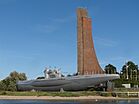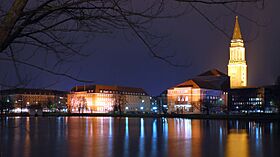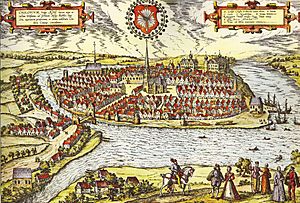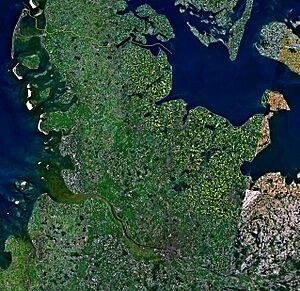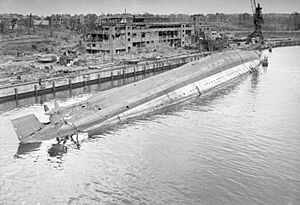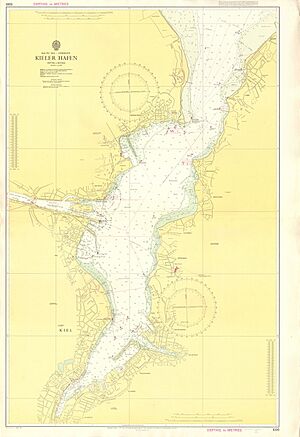Kiel facts for kids
Quick facts for kids
Kiel
|
|||
|---|---|---|---|
|
Top to bottom, left to right: aerial view including Kiel Fjord and harbor, city hall on Rathausplatz, Maritime Museum, Laboe Naval Memorial and submarine U-995, City Hall Tower and Opera House as seen from the Kleine Kiel
|
|||
|
|||
| Country | Germany | ||
| State | Schleswig-Holstein | ||
| District | Urban district | ||
| Elevation | 5 m (16 ft) | ||
| Population
(2022-12-31)
|
|||
| • City | 247,717 | ||
| • Metro | 643,594 | ||
| Time zone | CET/CEST (UTC+1/+2) | ||
| Postal codes |
24103–24159
|
||
| Dialling codes | 0431 | ||
| Vehicle registration | KI | ||
| Website | www.kiel.de | ||
Kiel is the capital city of Schleswig-Holstein, a state in northern Germany. It is the biggest city in the state, with about 246,000 people living there in 2021.
Kiel is located about 90 kilometers (56 miles) north of Hamburg. It is also about the same distance south of the border with Denmark. Because it sits on the southwestern shore of the Baltic Sea, Kiel is a very important place for ships and sea activities in Germany.
The city is famous for many international sailing events. The most well-known is the yearly Kiel Week, which is the largest sailing event in the world! Kiel is also known for the Kiel Mutiny. This happened during the last weeks of World War I when sailors refused to fight. This event helped start the German Revolution. This revolution led to the end of the Kaiser's rule and the start of the Weimar Republic. Kiel also hosted the Olympic sailing competitions in the 1936 and 1972 Summer Olympics.
Kiel has always been a key home for the German Navy's Baltic fleet. It is still a major center for building high-tech ships. The GEOMAR – Helmholtz Centre for Ocean Research Kiel is located here. It is part of the University of Kiel, which was started in 1665. Kiel is a busy transport hub because of its location on the Kiel Fjord and the Kiel Canal. The Kiel Canal is the busiest man-made waterway in the world. Many passenger ferries travel from Kiel to countries like Sweden, Norway, and Lithuania. Today, the Port of Kiel is also a popular stop for cruise ships exploring the Baltic Sea.
Kiel's recorded history began in the 13th century. Before that, it was a Danish village in the 8th century. Until 1864, it was ruled by Denmark. In 1866, the city became part of Prussia. Then, in 1871, it joined Germany.
Contents
History
Early Beginnings and Growth
The city of Kiel was founded in 1233. It was named Holstenstadt tom Kyle by Count Adolf IV of Holstein. In 1242, it was given special city rights by Adolf's son, John I. As part of Holstein, Kiel was in the Holy Roman Empire. It was only a few kilometers south of the Danish border.
Kiel was the capital of the area called Holstein. It was also a member of the Hanseatic League from 1284. This was a powerful group of trading cities. However, Kiel was kicked out in 1518 for helping pirates. The Kieler Umschlag (a big trade fair) started in 1431. It became the main market for goods and money in Holstein. This fair became less important around 1850 and stopped in 1900.
The University of Kiel was founded on September 29, 1665. It was started by Christian Albert, the Duke of Holstein-Gottorp. Many important thinkers and scientists studied or taught there. These included Theodor Mommsen and Max Planck.
From 1773 to 1864, the king of Denmark ruled Kiel. But Kiel was not officially part of Denmark. It was part of Germany, but the Danish king was also the Duke of Holstein. In 1848, Schleswig and Holstein fought against Denmark. Kiel became the capital of Schleswig-Holstein for a short time.
In 1864, during the Second Schleswig War, Kiel was taken over. It was conquered by an alliance of the Austrian Empire and Prussia. After this war, Kiel became part of Prussia in 1867. On March 24, 1865, King William I decided to base Prussia's Baltic Sea fleet in Kiel. The Imperial shipyard Kiel was built in 1867.
When William I became the Emperor of the German Empire in 1871, he made Kiel a main "Imperial War Harbour." The Kiel Yacht Club was started in 1887. Emperor Wilhelm II became its leader in 1891.
Because it was now a major naval base, Kiel grew very quickly. Its population went from 18,770 in 1864 to about 200,000 in 1910. Many old parts of the city were rebuilt to make space for the growing population. The Kiel tramway network opened in 1881. It grew to 10 lines before the end of First World War.
Kiel was the place where the sailors' mutiny started in late 1918. This led to the German Revolution. Near the end of World War I, the German fleet in Kiel was ordered to fight the British Navy. The sailors refused to go. They took control of Kiel and then spread to other German ports. This sparked the revolution that ended the monarchy and created the Weimar Republic.
During the Second World War, Kiel was still a very important naval base. It was also a key place for building ships and submarines. Because of this, the city was heavily bombed by the Allies. More than 80% of the old town was destroyed. Many homes and industrial areas were also badly damaged. For example, after a bombing in July 1944, there was no water for three days. Trains and buses stopped for eight days.
The port area was bombed many times in early 1945. This destroyed many U-boats and large warships. British forces took control of Kiel on May 5, 1945.
Like other German cities that were heavily bombed, Kiel was rebuilt after the war. In 1946, Kiel became the seat of government for Schleswig-Holstein. It officially became the state's capital in 1952.
Today, Kiel is once again a major maritime center in Germany. It is known for building advanced ships and submarines. It also has one of the world's largest ocean research centers, GEOMAR. Regular ferries connect Kiel to Scandinavia and Lithuania. The Kiel Week (Kieler Woche) is the biggest sailing event in the world. The Kieler Umschlag is another festival that has been held again since 1975. Kiel is also home to many services and research places. The University of Kiel is the oldest and largest university in the state.
Geography
Climate
Kiel has an oceanic climate. This means it has mild temperatures and rain throughout the year.
| Climate data for Kiel (1991–2020 normals, extremes 1940–present) | |||||||||||||
|---|---|---|---|---|---|---|---|---|---|---|---|---|---|
| Month | Jan | Feb | Mar | Apr | May | Jun | Jul | Aug | Sep | Oct | Nov | Dec | Year |
| Record high °C (°F) | 14.6 (58.3) |
17.7 (63.9) |
21.9 (71.4) |
29.3 (84.7) |
33.5 (92.3) |
34.4 (93.9) |
36.5 (97.7) |
35.1 (95.2) |
30.1 (86.2) |
25.2 (77.4) |
19.5 (67.1) |
14.8 (58.6) |
36.5 (97.7) |
| Mean daily maximum °C (°F) | 4.0 (39.2) |
4.6 (40.3) |
8.0 (46.4) |
12.7 (54.9) |
16.5 (61.7) |
19.8 (67.6) |
22.2 (72.0) |
22.1 (71.8) |
18.2 (64.8) |
13.1 (55.6) |
8.0 (46.4) |
5.0 (41.0) |
12.8 (55.0) |
| Daily mean °C (°F) | 2.0 (35.6) |
2.3 (36.1) |
4.4 (39.9) |
8.1 (46.6) |
12.0 (53.6) |
15.3 (59.5) |
17.7 (63.9) |
17.6 (63.7) |
14.2 (57.6) |
10.0 (50.0) |
5.8 (42.4) |
3.0 (37.4) |
9.3 (48.7) |
| Mean daily minimum °C (°F) | −0.4 (31.3) |
−0.4 (31.3) |
1.4 (34.5) |
3.9 (39.0) |
7.2 (45.0) |
10.5 (50.9) |
13.0 (55.4) |
13.1 (55.6) |
10.6 (51.1) |
6.9 (44.4) |
3.4 (38.1) |
0.9 (33.6) |
5.8 (42.4) |
| Record low °C (°F) | −20.8 (−5.4) |
−24.8 (−12.6) |
−14.5 (5.9) |
−6.9 (19.6) |
−3.0 (26.6) |
1.6 (34.9) |
4.3 (39.7) |
4.7 (40.5) |
0.6 (33.1) |
−6.2 (20.8) |
−12.0 (10.4) |
−15.1 (4.8) |
−24.8 (−12.6) |
| Average precipitation mm (inches) | 66.8 (2.63) |
49.7 (1.96) |
49.9 (1.96) |
39.7 (1.56) |
51.4 (2.02) |
65.1 (2.56) |
83.8 (3.30) |
77.3 (3.04) |
65.6 (2.58) |
72.1 (2.84) |
63.7 (2.51) |
70.5 (2.78) |
754.2 (29.69) |
| Average precipitation days (≥ 1.0 mm) | 18.6 | 16.8 | 15.3 | 13.2 | 13.4 | 14.0 | 15.3 | 15.6 | 15.4 | 17.1 | 18.4 | 19.3 | 190.7 |
| Average snowy days (≥ 1.0 cm) | 5.0 | 6.4 | 1.6 | 0.1 | 0 | 0 | 0 | 0 | 0 | 0 | 0.6 | 2.8 | 16.5 |
| Average relative humidity (%) | 86.7 | 84.1 | 80.3 | 74.8 | 73.4 | 73.9 | 73.8 | 75.5 | 79.4 | 82.5 | 86.5 | 88.0 | 79.9 |
| Mean monthly sunshine hours | 40.2 | 60.5 | 115.4 | 190.3 | 243.7 | 228.3 | 242.2 | 216.7 | 155.1 | 106.2 | 50.3 | 31.4 | 1,673.2 |
| Source 1: World Meteorological Organization | |||||||||||||
| Source 2: DWD (extremes) | |||||||||||||
City Districts
Kiel has about 40 different areas, or districts. These districts are often grouped into 30 boroughs. There is also a newer way to group them into 18 political districts. The city also has 25 areas for voting.
The largest districts by population are Gaarden (23,000 people), Mettenhof (20,000), and Elmschenhagen (17,000). Gaarden is a traditional working-class area. It used to be home to many shipyard workers. Mettenhof is a large housing area built in the 1960s and 1970s.
Districts like Düsternbrook, Schreventeich, Ravensberg, and Blücherplatz are popular places to live. They are north of the city center. These areas have many old buildings from the 1800s, fancy houses, and streets lined with trees. The government offices for Schleswig-Holstein are mostly in these neighborhoods. Unlike the city center, these residential areas were not badly damaged during World War II. So, Kiel has a mix of modern city parts and older, more historic neighborhoods.
There are plans to improve the inner city. These plans include better sidewalks and easier access to the waterfront. One notable plan is the "Kleiner Kiel Kanal." This will bring back a historic canal that was filled in for roads.
Main Sights
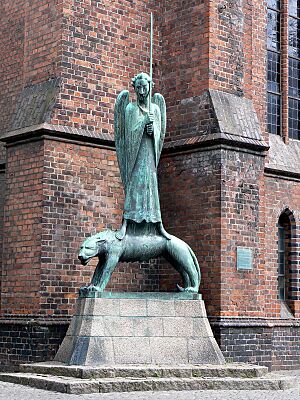
The oldest building in Kiel is the Church of St. Nicholas. It was built in the 13th century. In front of it, you can see a sculpture called Geistkämpfer by Ernst Barlach.
Kiel is the biggest city in Schleswig-Holstein. This means its shopping area is a big attraction. It will be improved even more in the coming years. Kiel's Holstenstraße (Holsten Street) is one of the longest shopping streets in Germany. The Rathaus (Town Hall) was built in 1911. Its tower looks like one in Venice. The square in front of the Town Hall has a lake and the Opernhaus Kiel (Kiel Opera House). There are also many lakes and parks in the city center, like Schrevenpark. Kiel has two botanical gardens: the Old Botanical Garden and the Botanischer Garten der Christian-Albrechts-Universität zu Kiel (New Botanical Garden).
Since Kiel is by the sea, the beaches north of the city are popular. Places like Strande, Kiel-Schilksee, Möltenort, and Laboe are great to visit in spring and summer.
Kiel Week, also known as the Kiel Regatta, is the world's largest sailing event. It happens every year in the last full week of June. Thousands of boats and ships of all types join a big parade. Kiel Week is also a fun festival with many activities for everyone. There are also several yachting and sailing clubs in beautiful locations.
Kiel also has many museums. These include museums about animals, geology, history, art, industry, and the military. The Stadt- und Schifffahrtsmuseum Warleberger Hof (City and Maritime Museum) is very interesting. It shows architecture from the 16th century and displays about city life and culture from the 19th and 20th centuries. The Schifffahrtsmuseum is in the old fish market building in the harbor.
Laboe is home to the Laboe Naval Memorial. You can also see the Second World War submarine U-995 there. Both are popular places for tourists to visit.
Population
| Historical population | ||
|---|---|---|
| Year | Pop. | ±% |
| 1300 | 1,000 | — |
| 1450 | 2,000 | +100.0% |
| 1682 | 3,310 | +65.5% |
| 1750 | 4,500 | +36.0% |
| 1871 | 31,764 | +605.9% |
| 1900 | 107,977 | +239.9% |
| 1919 | 205,330 | +90.2% |
| 1925 | 213,587 | +4.0% |
| 1933 | 218,335 | +2.2% |
| 1939 | 273,735 | +25.4% |
| 1951 | 259,629 | −5.2% |
| 1956 | 256,727 | −1.1% |
| 1961 | 273,284 | +6.4% |
| 1966 | 270,309 | −1.1% |
| 1971 | 269,437 | −0.3% |
| 1976 | 259,403 | −3.7% |
| 1981 | 249,786 | −3.7% |
| 1986 | 243,626 | −2.5% |
| 1990 | 245,567 | +0.8% |
| 2001 | 232,242 | −5.4% |
| 2011 | 235,782 | +1.5% |
| 2022 | 249,132 | +5.7% |
| Population size may be affected by changes in administrative divisions. Source: | ||
Kiel has a population of about 247,000 people. In 1946, when Kiel became the capital of Schleswig-Holstein, it had about 214,000 people. Kiel is the only state capital in Germany that is located directly on the sea. In the 1950s, many navy members moved to Kiel because of its marine port.
Kiel's population reached its highest point in 1973, with 273,000 people. After that, the population went down for a while. Many people moved away, and the city faced challenges with unemployment. However, Kiel is now a city with universities and active marine stations. This attracts many young students and people working in marine fields to Kiel.
| Rank | Nationality | Population (31 Dec. 2022) |
|---|---|---|
| 1 | 4,810 | |
| 2 | 4,430 | |
| 3 | 3,558 | |
| 4 | 2,240 | |
| 5 | 2,095 | |
| 6 | 1,355 | |
| 7 | 1,287 | |
| 8 | 1,015 | |
| 9 | 835 | |
| 10 | 693 |
Culture
Sports in Kiel
Kiel has several sports venues. The most famous is the Wunderino Arena. This arena is home to THW Kiel, one of the most successful team handball clubs in the world. They have won many German championships. Holstein Kiel, a soccer club, plays at Holstein-Stadion. They will play in the top German league, the Bundesliga, for the first time in their history in the 2024–2025 season.
Education and Research
The University of Kiel (Christian-Albrechts-Universität) was founded in 1665. It is the only full university in Schleswig-Holstein. About 27,000 students attend this university.
Other research places are connected to the University of Kiel. These include the German National Library of Economics and the Kiel Institute for the World Economy. The GEOMAR Helmholtz Centre for Ocean Research Kiel is also here. It is a major research center for ocean studies. There are also other schools like the Fachhochschule Kiel (a university of applied sciences) and the Muthesius School of Arts.
Kiel has twelve gymnasiums, which are high schools that prepare students for university. The Kieler Gelehrtenschule is the oldest, founded in 1320. Other high schools include Gymnasium Elmschenhagen and Max-Planck-Schule. There are also many other types of schools throughout the city.
Economy and Transport
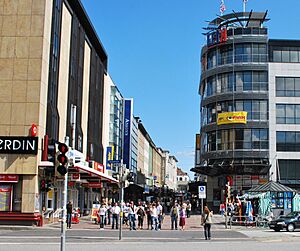
Kiel's economy mainly focuses on services, transport, and sea-related industries. Kiel is a major port for the German Navy. It is also a leading center for building advanced military and civilian ships.
Kiel is home to Howaldtswerke-Deutsche Werft (HDW). This shipyard was founded in 1838. It is famous for building submarines. HDW built the first German submarine, Brandtaucher, in 1850. Today, HDW is part of ThyssenKrupp Marine Systems. This is a top German group of shipyards.
Transport in Kiel
Kiel is close to an important European motorway, the A7. This road connects northern Europe with central and southern Europe.
The main train station, Kiel Hauptbahnhof, has trains every hour. These trains go to cities like Hamburg, Lübeck, and Flensburg. Faster Intercity Express (ICE) trains connect Kiel with major cities like Berlin, Frankfurt, and Munich. There are 8 smaller train stations within Kiel itself. You can use a regular bus ticket to travel between these stations and the main station.
Local buses are run by the KVG company. Regional bus services are provided by Autokraft and Verkehrsbetriebe Kreis Plön. The Schlepp- und Fährgesellschaft Kiel runs public ferries on the fjord.
The Port of Kiel is a very important port. It handles both passengers and cargo traveling from Germany to Scandinavia, the Baltic States, and Russia. Passenger ferries travel daily to Gothenburg in Sweden and Oslo in Norway. Ferries also go to Klaipėda in Lithuania several times a week. Cargo ferries also operate to and from Saint Petersburg and Kaliningrad in Russia.
The closest international airport is Hamburg Airport. It is about 90 kilometers (56 miles) south of Kiel. There is a special shuttle bus service, KIELIUS, that goes between Hamburg Airport and Kiel's main train station. There is also an airport in Lübeck.
Notable People
Twin Towns – Sister Cities
Kiel is connected with these cities around the world:
 Aarhus, Denmark (2019)
Aarhus, Denmark (2019) Antakya, Turkey (2012)
Antakya, Turkey (2012) Brest, France (1964)
Brest, France (1964) Coventry, United Kingdom (1947)
Coventry, United Kingdom (1947) Gdynia, Poland (1985)
Gdynia, Poland (1985) Kaliningrad, Russia (1992)
Kaliningrad, Russia (1992) Kherson, Ukraine (2024)
Kherson, Ukraine (2024) Moshi Rural District, Tanzania (2009)
Moshi Rural District, Tanzania (2009) Samsun, Turkey (2010)
Samsun, Turkey (2010) San Francisco, USA (2017)
San Francisco, USA (2017) Sovetsk, Russia (1992)
Sovetsk, Russia (1992) Stralsund, Germany (1987)
Stralsund, Germany (1987) Tallinn, Estonia (1986)
Tallinn, Estonia (1986) Vaasa, Finland (1967)
Vaasa, Finland (1967)
Images for kids
See also
 In Spanish: Kiel para niños
In Spanish: Kiel para niños





